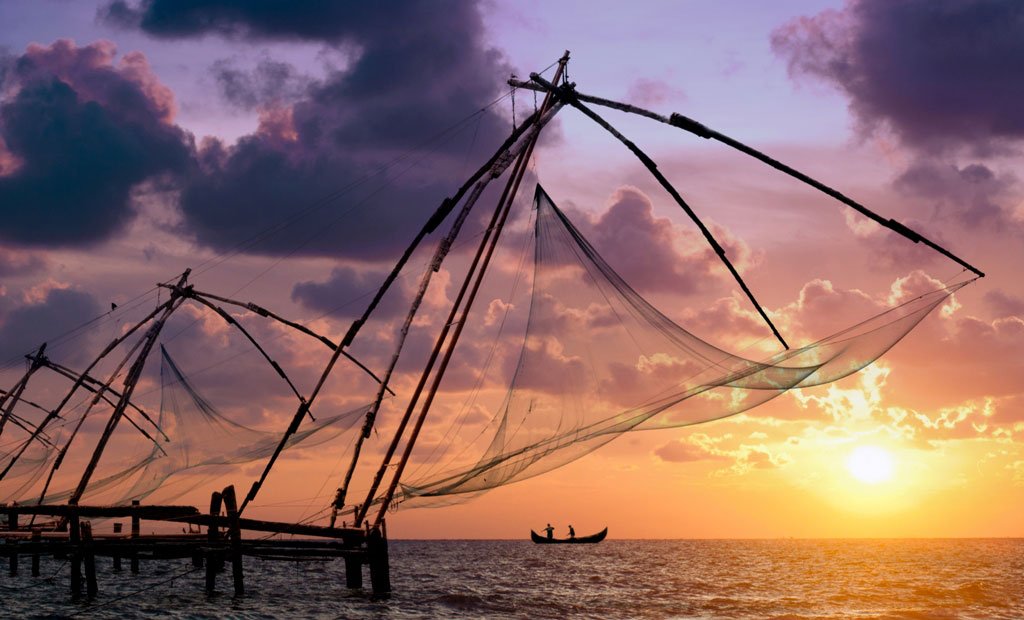Charming Fort Kochi (Cochin) is an island of slowly disintegrating stone walls, crumbling shopfronts and well-tended churches.
Charming Fort Kochi (Cochin) and its twin town Mattancherry is an island of slowly disintegrating stone walls, crumbling shopfronts and well-tended churches, where every turn takes you down some new gloriously picturesque, narrow winding street. New building was only actually banned in 1976 – but most of the ramshackle island still feels frozen way back in the 15th and 16th centuries, and the huge trees here are so old their parasitic aphids are tall as trees themselves.
Kochi was a fishing village in pre-colonial Kerala. The territory that would later be known as Fort Kochi was granted to the Portuguese in 1503 by the Rajah of Kochi, after the forces of Afonso de Albuquerque helped him fight the forces of Saamoothiri of Kozhikode. The Rajah also gave them permission to build Fort Emmanuel near the waterfront to protect their commercial interests. The first part of the name Fort Kochi comes from this fort, which the Dutch later destroyed.
A mix of old houses built by the Portuguese, Dutch and British in these colonial periods line the streets of Fort Kochi. St Francis Church was built in 1503 by the Portuguese as a Catholic church. Vasco da Gama was once buried in this church which now falls under the Church of South India and is one of the national monuments. Santa Cruz Basilica, also built by the Portuguese in the 16th century, was later destroyed by the British and rebuilt near the end of 19th century. The landmark that causes more public and visitor interest is a series of pre-colonial Chinese fishing nets on the waterfront, believed to have been introduced by Chinese traders in the early 14th century.
Other attractions include the 16th century Bishop’s House, previously the Portuguese governor’s house, now home to Kochi’s bishop. Koder House, the residence of Satu Koder, patriarch of Kochi’s Jews, was built by his ancestors in 1808 and has now been converted into a beautiful hotel. The historic Malabar House Residency is now also a wonderful hotel.
Fort Kochi has now been declared a Heritage Zone to preserve its many historical buildings.
Below is a list of popular places to visit in Fort Kochi.
1. Chinese Fishing Nets
[singlepic id=1201 w=720 h=560 float=center]At the tip of Fort Cochin sit the unofficial emblems of Kerala’s backwaters: cantilevered Chinese fishing nets. They have become a very popular tourist attraction in Fort Kochi. These are not unique to Kochi, but are perhaps uniquely accessible to the short-stay visitor.
2. St Francis Church
[singlepic id=1229 w=720 h=560 float=center]Believed to be India’s oldest European-built church, St Francis Church Kochi was originally constructed in 1503 by Portuguese Franciscan friars. The present stone building that stands here today was built in the mid-16th century to replace the original wooden structure. Adventurer Vasco da Gama, who died in Cochin in 1524, was buried in this spot for 14 years before his remains were taken to Lisbon – you can still visit his tombstone in the church.
3. Santa Cruz Basilica
[singlepic id=1198 w=720 h=560 float=center]Located next to St Francis Church in Fort Kochi, the Santa Cruz Basilica is one of the eight Basilicas in India. This church is one of the finest and most impressive churches in India and visited by tourists the whole year round. It is a place of devotion as well as a centre of historic significance, endowed with architectural and artistic grandeur and colours of the Gothic style.



Very nice post. I just stumbled upon your weblog and wanted to say
that I’ve truly enjoyed browsing your blog posts.
In any case I’ll be subscribing in your rss feed and I’m hoping you write again soon!
Thanks Cathey. 🙂